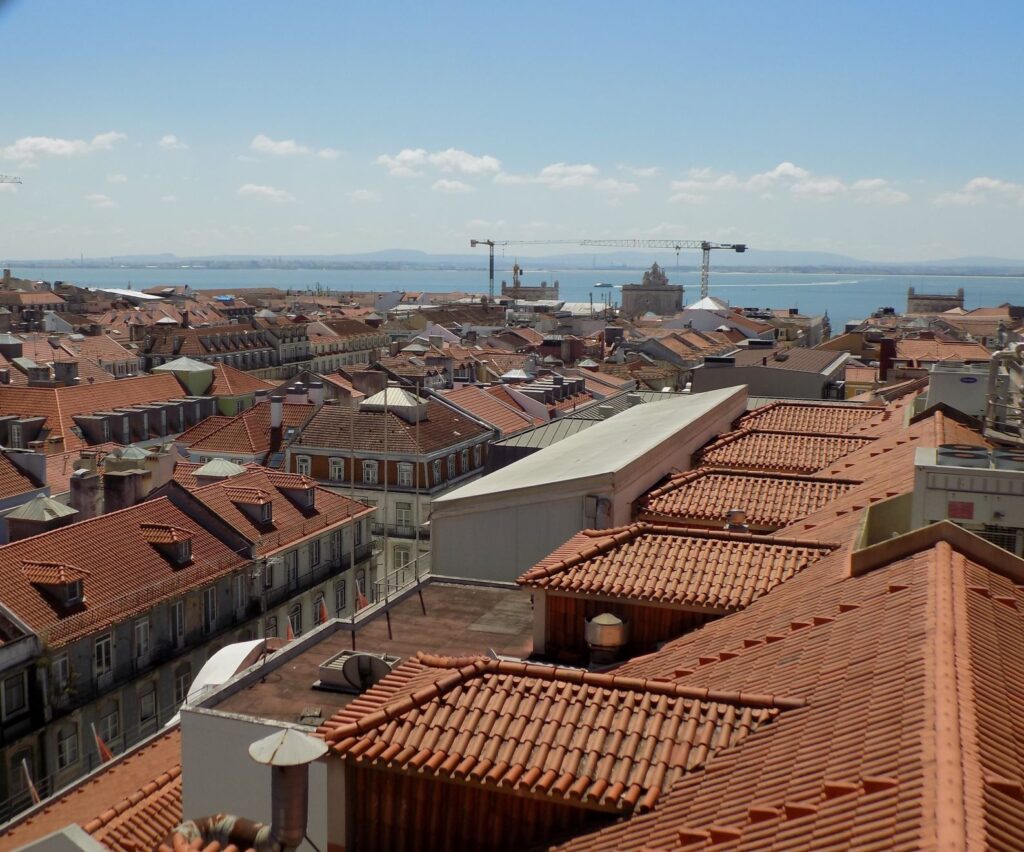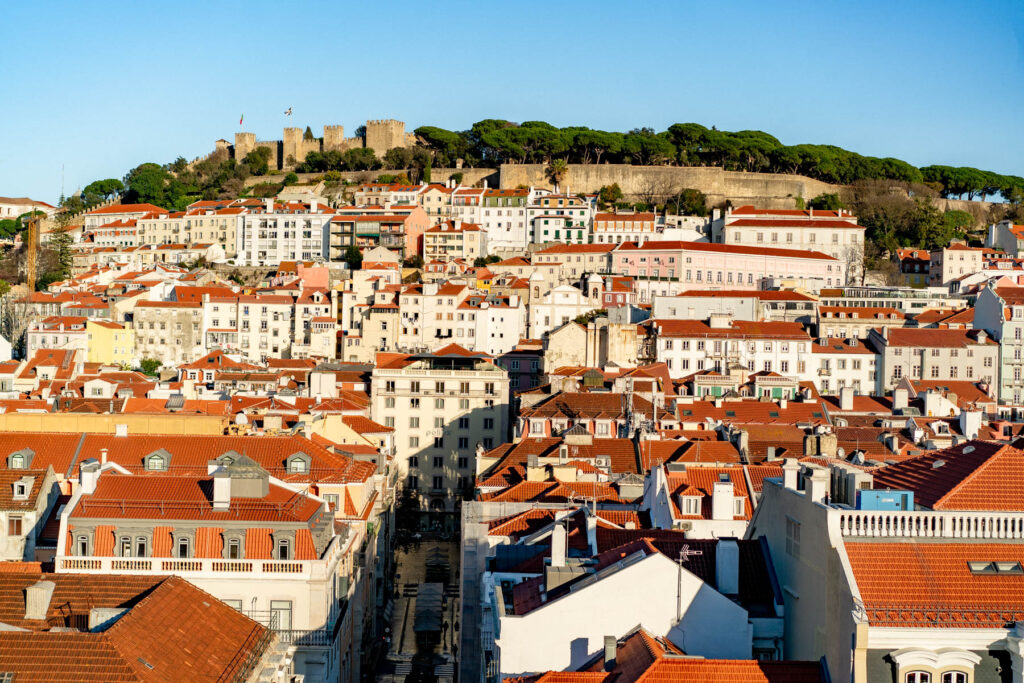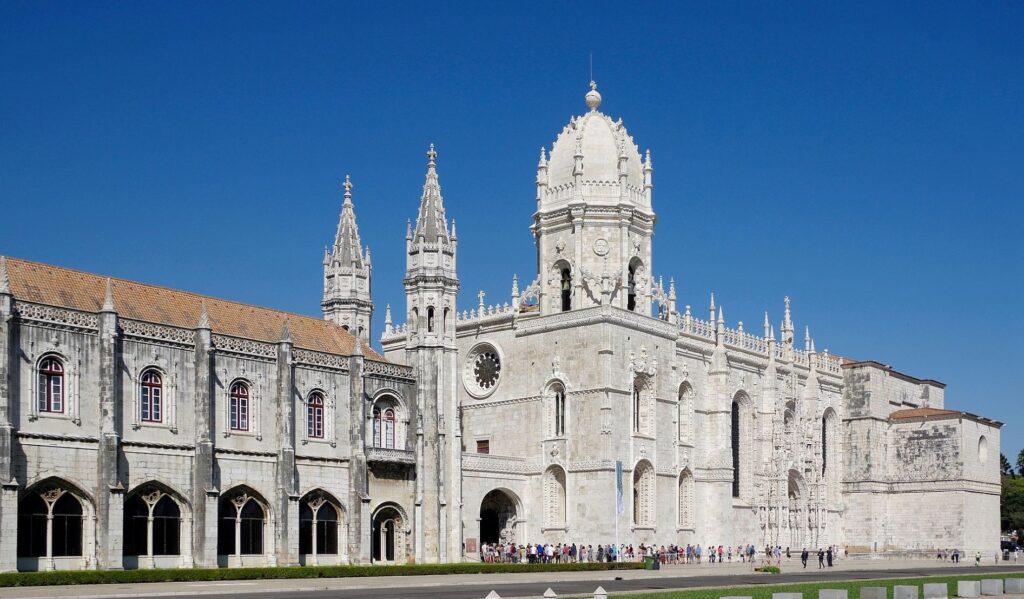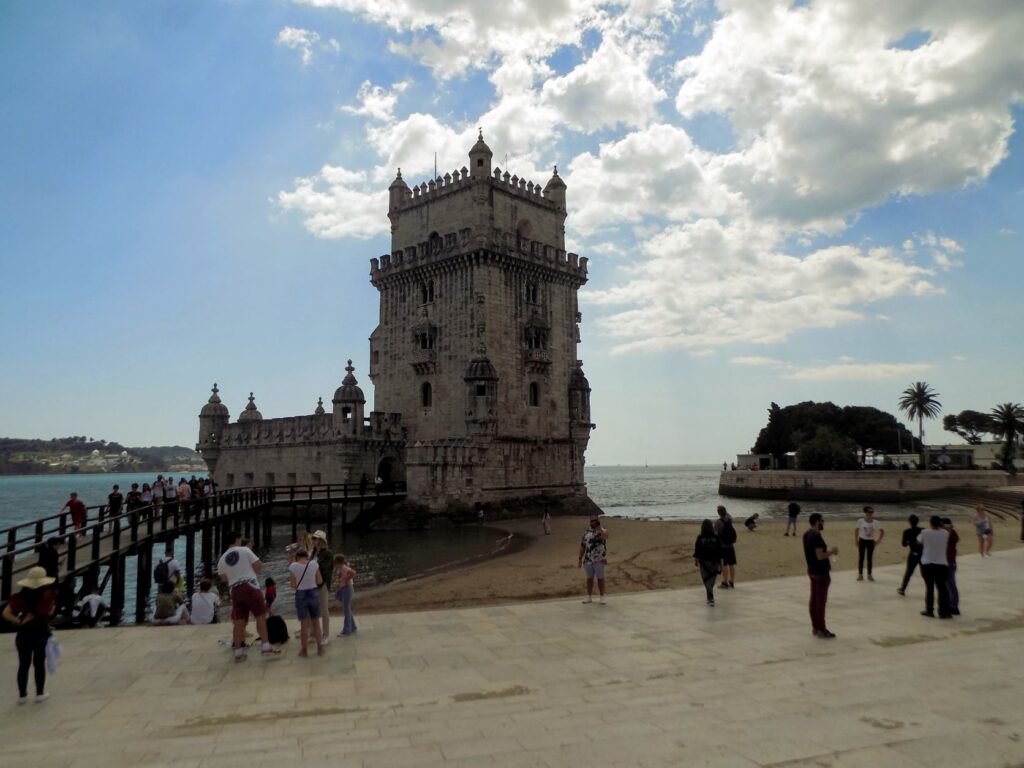My time with Ana was winding down as we walked past the Convento do Carmo and onto the bridge that led to the Elevador de Santa Justa. Unlike the Elevador da Glória – which is a funicular – Santa Justa is an actual elevator designed and built by Raoul Mesnier du Ponsard who was a student of Gustave Eiffel. The lift carries passengers 45 meters from Baixa to the Carmo area of Chiado and is found in most tourist guides to Lisbon. Perhaps more impressive than the structure itself are the views of the city it affords whether across Baixa toward the river,

or across the city toward the castle.

Baixa – sometimes called Baixa-Pombalina – is Lisbon’s downtown. Any buildings that remained after the 1755 earthquake and ensuing tsunami were razed in accordance with the radical rebuilding plan put forward by King José’s chief engineer, Manuel da Maia, that the king adopted, and was implemented by the Marquês de Pombal. In addition to constructing earthquake resistant buildings, Pombal abandoned the organic street plan that characterized the district before the earthquake widening the streets and installed a grid pattern instead.
Going down.
As we descended the Escadinhas de Santa Justa (Santa Justa Stairs) Ana provided some guidance and suggestions regarding the best way to see some of the places I wanted to see and the best way for me to spend my afternoon.
We parted ways at the large and visually striking square known simultaneously as Terreiro do Paço and Praça do Comércio.

During the 15th and 16th centuries, the period the Portuguese call the Discoveries, the square was a main gateway to the capital city and the location of the royal palace called Paço de Ribeira that housed a massive 70,000 volume library. But all of that was before the Earthquake. The oldest buildings now on the square date from the 18th century.
The Terreiro do Paço was also the site of the 1908 assassination of King Carlos the First (whom we first met in Cascais) and his oldest son Prince Luís Filipe. The Prince’s younger brother Prince Manuel would be Portugal’s last king. (The Portuguese had a wonderful habit or tradition of attaching descriptive epithets to the names of their royals. Carlos, you might recall, was called “the Diplomat,” “the Oceanographer,” and “the Martyr” while Manuel was known as “the Patriot” or “the Unfortunate.”)
Walk north through the triumphal arch on the left of the photo above and you enter the busy commercial area of Baixa and its main pedestrian street rua Augusta. Continue for a kilometer or so and you’ll reach the Avenida da Liberdade. For the moment, my plans were to walk east between the yellow buildings into the Alfama neighborhood to see the Casa dos Bicos or House of Beaks mainly because it’s something of an architectural oddity.
Although construction of the building began in the renaissance, its style is more evocative of Portuguese Gothic with its exterior lattice of diamond-like stubs and curiously shaped and placed windows. Somehow, it survived the earthquake and was left standing. Today, it houses the Saramago Foundation and is a museum mainly dedicated to the Nobel Prize winning writer.

From there I made the short walk back to the square to hop on the 15E tram to finish my sightseeing with a walk past the Jerónimos Monastery, the Belem Tower, and a visit to the National Coaches Museum that Ana had recommended. Meanwhile, you can now look at all the photos from my time with Ana.
HIE-RON-Y-MITE!
That I had decided to go out of the way to visit (at least in some way) the Monasterio do los Jerónimos de Belém might be a bit eyebrow raising to regular readers of this blog. I’ve made no secret of my apostasy and as recently as the previous post noted my antipathy toward seeing “Another Bloody Church.” Your skepticism merits an explanation.
The story begins in the early 15th century with Infante Dom Henrique, o Navegador (Prince Henry, the Navigator) who built the small chapel (enlarged considerably afterward) of Santa Maria de Belém on the site.

[Photo from Wikimedia Commons By Velvet CC-by-SA 4.0.]
Monks belonging to the military-religious Order of Christ (most likely Knights Templar) were duty bound to assist Portuguese sailors and ships leaving port for the long journeys that characterized the Portuguese Age of Discovery. Vasco da Gama, the first European to reach the Far East by sea, credited spending a night of prayer in the church before setting sail with his success.
Soon after da Gama’s return in July 1499, King Manuel the First ordered the construction of a new monastery on the site intended to showcase Portugal’s newfound wealth and power. Scheduled to take eight years and financed by a five percent tax on spices and other goods imported from southeast Asia, construction began in 1502. However, the income proved so vast that the project expanded far beyond its original design and intent and it wasn’t officially completed until 1604.
Early in its construction, Manuel donated the monastery to monks of the Hieronymite (dedicated to Saint Jerome) Order. He chose this particular order because they promised spiritual protection for him and his family after their deaths. These monks had taken on a great challenge considering the atrocities committed by Portuguese explorers and traders in the king’s name. Then again, who would know if they failed or succeeded?
A number of elements make the monastery a place worth seeing. First, despite taking more than a century to complete, it’s a remarkably cohesive representation of the late Gothic or Manueline style.

Second, it’s one of the few buildings that survived the 1755 earthquake nearly intact (though it did suffer considerably in the wake of the 1834 nationalization). Third, it’s one of Lisbon’s UNESCO World Heritage Sites. Still, in keeping with my inclinations, seeing the exterior was sufficient.
Belém up to the bar.
Although it incorporates elements of the Gothic and Italian Renaissance styles, you can find another example of Manueline architecture not far from the monastery that’s considered part of the same UNESCO Heritage site – the Torre de Belém or Belém Tower.

Initially proposed in the late 15th century by King João II as a means to bolster defense of his capital and coast, construction on the tower where the Tejo (Tagus) River meets the Atlantic Ocean didn’t actually begin until 1516 under King Manuel. It was completed in 1519. Sitting opposite the pre-existing Fort of São Sebastião da Caparica and designed in a way that led historian Damião de Góis to assert that “no ship could pass by without being seen,” the two structures created not only a formidable defense of Lisbon’s harbor but Belém also served as a customs and health checkpoint for those arriving by sea.
Inside, the Tower has five levels. The Governor’s Hall on the first floor opens into the cistern and connects with the upper levels via a spiral staircase. One level up, the King’s Hall opens to the loggia for a clear view of the river. The top two levels are the Audience Hall and the chapel. Unlike the concrete slab ceilings of the three floors below it, the chapel has a vaulted rib ceiling. The lowest level was used initially to store gunpowder but after 1580 also served as a prison.
Once again, thanks to Atlas Obscura, I knew to look for one of the Tower’s oddities, the carved head of a rhinoceros on one of the watchtowers. Why a rhinoceros you wonder?
Well, during negotiations to permit the Portuguese to build a fort in Diu, Sultan Muzaffar Shah II, ruler of the Gujarat Sultanate, sent a living rhinoceros to Manuel’s representative, Afonso de Albuquerque. Somehow, the rhino, named Genda, survived a four month sea journey to Lisbon and arrived at the Tower in 1515. It’s generally believed that Genda was the first living rhinoceros in Europe since the fall of the Roman Empire. Genda was memorialized in a print by Albrecht Durer and by this carving

on the tower.
Following my visit to the National Coaches Museum where I saw nearly 500 years of the history of royal and noble transportation – including the car occupied by King Carlos at the time of his 1908 assassination – the day grew late and I needed to return to the hotel to prepare for a very special dinner that held an event so surprising I don’t believe anything could have prepared me for it.
But first, I would become a public transit scofflaw in a third European capital even if this adventure was closer to the one in Paris than what happened in Budapest. As in Paris, I boarded a tram that was so crowded, I couldn’t make my way to the card reader to validate my fare. By the time the crowd had dissipated enough to allow it, I made the conscious choice to avoid it because by that point I wanted to add Lisbon to my scofflaw list.
Meanwhile, here’s where you can see the rest of the photos from the day.